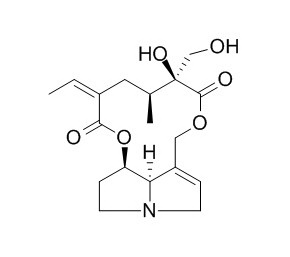Usaramine
Usaramine may have hepatotoxic.
Inquire / Order:
manager@chemfaces.com
Technical Inquiries:
service@chemfaces.com
Tel:
+86-27-84237783
Fax:
+86-27-84254680
Address:
1 Building, No. 83, CheCheng Rd., Wuhan Economic and Technological Development Zone, Wuhan, Hubei 430056, PRC
Providing storage is as stated on the product vial and the vial is kept tightly sealed, the product can be stored for up to
24 months(2-8C).
Wherever possible, you should prepare and use solutions on the same day. However, if you need to make up stock solutions in advance, we recommend that you store the solution as aliquots in tightly sealed vials at -20C. Generally, these will be useable for up to two weeks. Before use, and prior to opening the vial we recommend that you allow your product to equilibrate to room temperature for at least 1 hour.
Need more advice on solubility, usage and handling? Please email to: service@chemfaces.com
The packaging of the product may have turned upside down during transportation, resulting in the natural compounds adhering to the neck or cap of the vial. take the vial out of its packaging and gently shake to let the compounds fall to the bottom of the vial. for liquid products, centrifuge at 200-500 RPM to gather the liquid at the bottom of the vial. try to avoid loss or contamination during handling.
Lab Chip.2018, 18(6):971-978
Turkish Journal of Pharmaceutical Sciences2022, DOI: 10.4274
Universiti Tunku Aboul Rahman2023, 6263.
Oncol Lett.2020, 20(4):122.
Front Plant Sci.2021, 12:673337.
FUTURE VIROLOGYVOL.2023, 18(5).
J Herbmed Pharmacol.2018, 7(4):280-286
Int Immunopharmacol.2021, 101(Pt A):108181.
Int J Mol Sci.2021, 22(19):10220.
Nutrients.2023, 15(24):5020.
Related and Featured Products
Rapid communications in mass spectrometry : RCM, 2008, 22(4):591-602.
Identification of five hepatotoxic pyrrolizidine alkaloids in a commonly used traditional Chinese medicinal herb, Herba Senecionis scandentis (Qianliguang).[Reference:
WebLink]
Senecio scandens Buch.-Ham is a plant source for a commonly used traditional Chinese medicinal (TCM) herb Qianliguang. A TCM herbal proprietary product containing Qianliguang as the major herb for the treatment of sinusitis has been used in China for several decades, and has also been exported to other regions and countries worldwide.
METHODS AND RESULTS:
In the present study, the aqueous extract of S. scandens collected in the Shanxi Province of China was determined, for the first time, to contain hepatotoxic and tumorigenic pyrrolizidine alkaloids (PAs) by using high-performance liquid chromatography/mass spectrometric (HPLC/MS) analysis in various scanning modes. A total of nine toxic and two non-toxic PAs were detected in the aqueous extract of S. scandens, of which six PAs, namely neoplatyphylline, senecionine, senecionine N-oxide, seneciphylline, seneciphylline N-oxide and senkirkine, were unequivocally characterized, while other PAs were tentatively assigned as jacobine, jacozine N-oxide (or erucifoline N-oxide), 7-tigloylplatynecine, Usaramine and an isomer of yamataimine. The estimated total content of toxic PAs in S. scandens was 10.82 microg/g herb, which was significantly higher than that (> or =1 microg/g herb) recommended by Belgium and Germany not to be used clinically. Among the PAs definitively identified, senecionine, seneciphylline, and senkirkine are known tumorigens capable of inducing liver tumors in experimental animals, while seneciphylline N-oxide and senecionine N-oxide are probably tumorigenic due to their potential conversion into seneciphylline and senecionine via metabolic reduction in the body.
CONCLUSIONS:
Thus, the current finding of the presence of toxic/tumorigenic PAs in S. scandens challenges the safety of using this TCM herb and its proprietary products.
Journal of Ethnopharmacology, 1994, 43(1):19-30.
Hepatotoxic pyrrolizidine alkaloids in the Mexican medicinal plant Packera candidissima (Asteraceae: Senecioneae).[Reference:
WebLink]
A study of the hepatotoxic pyrrolizidine alkaloids (PAs) contained in Packera candidissima (Greene) Weber & Löve (Senecio candidissimus Greene), a Mexican medicinal plant used for the treatment of kidney ailments and noted for its antiseptic properties, is reported.
METHODS AND RESULTS:
Analysis by TLC and GC-MS have shown the presence in high levels of both PAs and their N-oxides in the root (0.76% dry weight) and the aerial parts (0.36% dry weight) of the plant material. GC-MS analysis showed the presence of senecionine, integerrimine, retrorsine, and Usaramine in the aerial parts. The root was found to contain senkirkine as the major component.
CONCLUSIONS:
These results indicate that users of this herb are at high risk of poisoning, especially members of certain cultural groups in Northern Mexico and the Hispanic population in the southwestern United States. In addition, two sesquiterpenes, neoadenostylone and epineoadenostylone were identified from the neutral extracts of this plant material. The 6α-angeloyloxy-9-oxo-Δ10(1)-furanoeremophilane is reported for the first time as a natural product.
Australian Journal of Chemistry, 1966, 19(11):2127-2131.
Usaramine, a New Pyrrolizidine Alkaloid from Crotalaria Usaarmoensis E. G. Baker.[Reference:
WebLink]
METHODS AND RESULTS:
The major alkaloid, Usaramine, of the seed of C. usaramoensis E. G. Baker, is shown to be the geometric isomer of retrorsine; i.e. an ester of retronecine with retronecic acid.
CONCLUSIONS:
Other alkaloids in the seed are integerrimine, traces of senecionine and retrorsine, and two unidentified non-ester bases. The previously reported usaramoensine1 was not detected and is considered to be a mixture.



